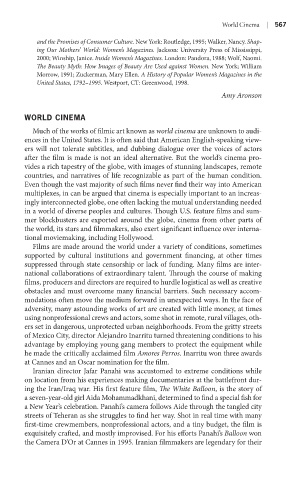Page 588 - Battleground The Media Volume 1 and 2
P. 588
World C nema |
and the Promises of Consumer Culture. New York: Routledge, 1995; Walker, Nancy. Shap-
ing Our Mothers’ World: Women’s Magazines. Jackson: University Press of Mississippi,
2000; Winship, Janice. Inside Women’s Magazines. London: Pandora, 1988; Wolf, Naomi.
The Beauty Myth: How Images of Beauty Are Used against Women. New York; William
Morrow, 1991; Zuckerman, Mary Ellen. A History of Popular Women’s Magazines in the
United States, 1792–1995. Westport, CT: Greenwood, 1998.
Amy Aronson
world CineMa
Much of the works of filmic art known as world cinema are unknown to audi-
ences in the United States. It is often said that American English-speaking view-
ers will not tolerate subtitles, and dubbing dialogue over the voices of actors
after the film is made is not an ideal alternative. But the world’s cinema pro-
vides a rich tapestry of the globe, with images of stunning landscapes, remote
countries, and narratives of life recognizable as part of the human condition.
Even though the vast majority of such films never find their way into American
multiplexes, in can be argued that cinema is especially important to an increas-
ingly interconnected globe, one often lacking the mutual understanding needed
in a world of diverse peoples and cultures. Though U.S. feature films and sum-
mer blockbusters are exported around the globe, cinema from other parts of
the world, its stars and filmmakers, also exert significant influence over interna-
tional moviemaking, including Hollywood.
Films are made around the world under a variety of conditions, sometimes
supported by cultural institutions and government financing, at other times
suppressed through state censorship or lack of funding. Many films are inter-
national collaborations of extraordinary talent. Through the course of making
films, producers and directors are required to hurdle logistical as well as creative
obstacles and must overcome many financial barriers. Such necessary accom-
modations often move the medium forward in unexpected ways. In the face of
adversity, many astounding works of art are created with little money, at times
using nonprofessional crews and actors, some shot in remote, rural villages, oth-
ers set in dangerous, unprotected urban neighborhoods. From the gritty streets
of Mexico City, director Alejandro Inarritu turned threatening conditions to his
advantage by employing young gang members to protect the equipment while
he made the critically acclaimed film Amores Perros. Inarritu won three awards
at Cannes and an Oscar nomination for the film.
Iranian director Jafar Panahi was accustomed to extreme conditions while
on location from his experiences making documentaries at the battlefront dur-
ing the Iran/Iraq war. His first feature film, The White Balloon, is the story of
a seven-year-old girl Aida Mohammadkhani, determined to find a special fish for
a New Year’s celebration. Panahi’s camera follows Aide through the tangled city
streets of Teheran as she struggles to find her way. Shot in real time with many
first-time crewmembers, nonprofessional actors, and a tiny budget, the film is
exquisitely crafted, and mostly improvised. For his efforts Panahi’s Balloon won
the Camera D’Or at Cannes in 1995. Iranian filmmakers are legendary for their

